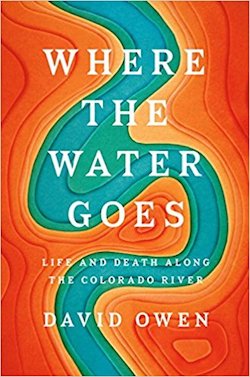SEJournal Online is the digital news magazine of the Society of Environmental Journalists. Learn more about SEJournal Online, including submission, subscription and advertising information.
BookShelf
“Where the Water Goes: Life and Death Along the Colorado River”
By David Owen
Riverhead Books, $28.00
Reviewed by Karen Schaefer
As someone who grew up in northern Colorado, I thought I knew the Colorado River.
As a child, I visited the wet meadow in Rocky Mountain National Park where the Colorado begins as a tiny stream just west of the Continental Divide. I traveled beside it on I-70 as the Colorado River flows across the the Colorado plateau and into southern Utah. I'd stood on the rim of the Grand Canyon in northern Arizona and glimpsed at the river below.
 |
But I realized I had a lot more to learn after reading New Yorker writer David Owen's latest book, “Where the Water Goes: Life and Death Along the Colorado River.”
The Colorado River flows 1,450 miles through seven Western states. It supplies water to more than 36 million people in cities such as Denver, Las Vegas, Tucson and Los Angeles. It irrigates more than six million acres of farmland, including southern California's Imperial Valley. Two of its most iconic hydroelectric dams — Glen Canyon and Hoover — form the nation's largest man-made reservoirs, Lake Powell and Lake Mead.
Every drop of the Colorado River is allocated to users — not just downstream, but east of the Continental Divide — through a byzantine system of Western water laws based not on proximity to the river, but on who claimed the right to use the water first.
In fact, the waters of the Colorado are so heavily allocated that, until recently, the river dried up before it reached Mexico, and the once-lush wetlands of its historic delta in the Gulf of California have become a million-acre desert.
The Colorado’s story isn’t just of Western water
Owen tells the story of the Colorado by tracing the river from its headwaters to its delta, then fanning out to track its many diversions.
But this is not just a Western water story.
In “Where the Water Goes,” Owen explores water issues familiar in many other parts of the country and the world: from drought and climate degradation to cross-state and cross-border legal complexities, and from aging infrastructure to burgeoning eco-technologies — all told from the perspective of farmers, water managers, dam operators, politicians and environmental activists.
Owen begins his journey by flying over the headwaters of the Colorado with Jennifer Pitt, then a researcher with the Environmental Defense Fund.
From the air, Owen and Pitt trace the series of dams, reservoirs and tunnels that gather and store water from the Colorado River watershed, then send it over the Continental Divide to slake the thirst of fast-growing Front Range cities from Fort Collins to Denver.
As Pitt says: “Even people who describe themselves as worried environmentalists have no idea where their water comes from.”
Ultimately, real solutions must rely on better federal policy
which encompasses the river system as a whole,
not relying on states to create piecemeal solutions.
Owen's masterly discussion of Western water laws sets up our understanding of the complex system of water-sharing.
It began with gold miners who needed water for their sluice boxes, but found there wasn't enough in many western streams to share.
So the first miners to file claims got the water. Irrigation for arable land later followed the same principle. By the turn of the 19th century, it was already legal to transport water long distances. And distant states began to stake their claims for Colorado River water, too.
In the 20th century, the national push to harness rivers to generate power, control flooding and store water for future use led to the construction of many dams on the Colorado.
Each resulting reservoir helped upstream states meet their quota of water to be shared with downstream and out-of-basin users. Owen visits each in turn, lingering on the two largest: the 1966 Glen Canyon Dam, which formed Lake Powell west of the Grand Canyon, and 1936 Hoover Dam, which created Lake Mead on the border between Arizona and Nevada.
Despite declining reservoir levels over the last decade-and-a-half, Lake Powell's biggest beneficiary remains southern California; it also pumps water hundreds of miles south to Phoenix and Tucson.
Owen says these days Lake Powell — which flooded Glen Canyon over national protests by groups such as the Sierra Club and the National Park Service — serves primarily as the storage tank for downstream Lake Mead, which also supplies water to Las Vegas.
How water conservation can backfire
That desert gambling oasis has implemented some of the most stringent water conservation measures in the United States.
But here's a surprise: Water conservation can backfire. In Las Vegas, practices such as xeriscaping — that is, replacing lawns with desert plants — have robbed the local springs of groundwater they need to recharge.
Owen says there's a similar impact on western streams when irrigation leaks are repaired.
As he makes his way down the Colorado, Owen uncovers other surprising nuggets: that Hoover Dam water intakes are fighting quagga mussels (an invasive species imported from the Black Sea via the Great Lakes); that groundwater depletion in countries like China has led to California using Colorado River water to grow animal fodder for overseas export; that the Salton Sea (championed by Sonny Bono) in southern California is dying from salinity as an unintended consequence of preventing the Colorado from flooding the Imperial Valley.
Owen offers one hopeful story. Water managers in the United States and Mexico negotiated an agreement to allow an annual “pulse flow” of water down the river, so that in 2014 the Colorado River once again reached the Gulf of California for the first time in 60 years. The manmade flood is still a far cry from the water amounts that used to flow into the delta. But it's a start.
Owen examines possible solutions to the many challenges facing the Colorado and its over-allocated water: from cloud-seeding to desalinization; from prioritizing agricultural use of water to managing population growth.
Ultimately, Owen says real solutions to problems in river systems such as the Colorado must rely on better federal policy which encompasses the river system as a whole, not relying on states to create piecemeal solutions.
The decade-and-a-half drought in the American Southwest — and other places around the world — isn't going away. Owen's book offers a global lesson on the implications of our much-altered waterways — and a vision for how we might change the way we think about them.
Karen Schaefer is an Ohio-based freelance radio journalist who covers water issues.
* From the weekly news magazine SEJournal Online, Vol. 2, No. 28. Content from each new issue of SEJournal Online is available to the public via the SEJournal Online main page. Subscribe to the e-newsletter here. And see past issues of the SEJournal archived here.














 Advertisement
Advertisement 




